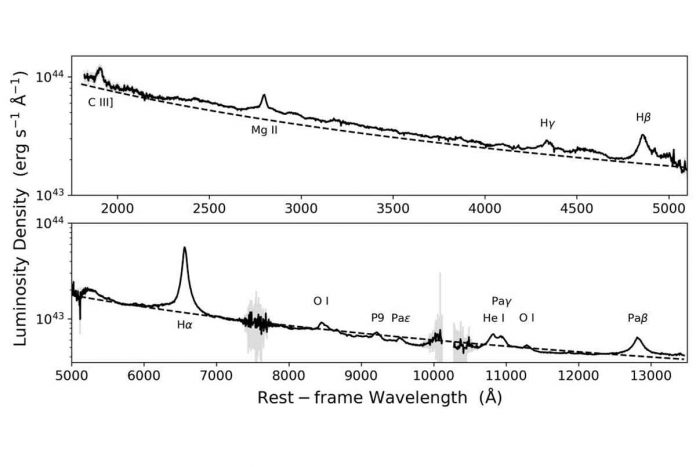A new luminous quasi-stellar object, or quasar, has been discovered by an international team of astronomers. SMSS J114447.77-430859.3 (or J1144 for short) turns out to be the most luminous quasar discovered in the last 9 billion years of cosmic history. The discovery was announced in a paper published on the arXiv pre-print repository on June 9.
Quasars are extremely bright active galactic nuclei (AGN) that emit electromagnetic radiation visible in radio, infrared, visible, ultraviolet, and X-ray wavelengths. They are among the brightest and most distant objects in the known universe, and they serve as fundamental tools for numerous astrophysical and cosmological studies. Quasars, for example, have been used to study the large-scale structure of the universe and the era of reionization. They also helped us better understand the dynamics of supermassive black holes and the intergalactic medium.
Astronomers led by Christopher A. Onken of the Australian National University (ANU) in Canberra, Australia, recently conducted a spectroscopic study of a bright, blue, point-like source selected from the SkyMapper Southern Survey Data Release 2. (SMSS DR2). The study, conducted primarily with the South African Astronomical Observatory’s (SAAO) 1.9-meter telescope and its SpUpNIC (Spectrograph Upgrade: Newly Improved Cassegrain) instrument, discovered that this source, designated J1144, is a quasar with a redshift of 0.83.
J1144 has a bolometric luminosity of about 470 quadrillion erg/s, making it the most luminous quasar in the last 9 billion years, according to the study. At a redshift greater than 0.4, it is also the optically brightest (unbeamed) quasar.
The black hole in J1144 is estimated to be 2.6 billion solar masses in mass by astronomers. This value, combined with the bolometric luminosity, results in an Eddington ratio of 1.4 for this quasar.
It was observed that J1144’s high luminosity implies a large size of its broad line region (BLR). According to the findings, the size of the hydrogen-beta (H) emitting region is approximately 1,200 light days. The angular size of the BLR, on the other hand, is expected to be greater than 100 microarcseconds.
The authors of the paper summarised the findings by explaining how the properties of J1144 may be useful for future observations.
“Additional research could benefit from using an extremely bright quasar like J1144 as a background source. UV spectroscopy of J1144, for example, could probe the Milky Way’s circumgalactic medium “The researchers wrote about it in their paper.
A spectroscopic campaign using the ANU 2.3m telescope has already identified about 80 new, bright quasars, according to the astronomers. As a result, their new research is an important step toward completing the census of bright quasars.

